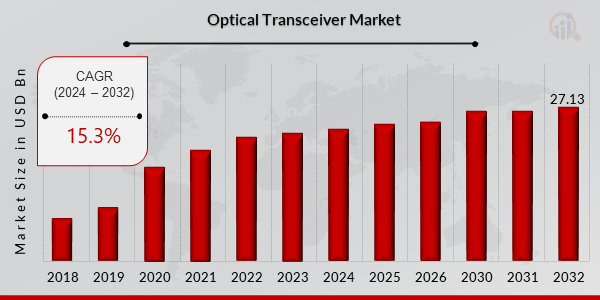Global Optical Transceiver Market Overview
The global optical transceiver market is estimated to reach a valuation of USD 27.13 billion by the end of the year 2032 at a CAGR of 15.3% during the forecast period 2024 to 2032. set to increase during the ongoing forecast period of 2024-2032. The key elements driving the optical transceiver market are a rush in data traffic and increased internet usage.
The increased distribution of VoIP, LTE, and 5G networks aids in the growth of the optical transceiver market. The rise in the adoption of AI and IoT is likely to provide remunerative opportunities for the market's growth during the said forecasted period. In networking visual communication, the information is sent through an optical fiber in the form of pulses of light. The optical transceiver plays an important role in networking visual communication, where the information is sent through an optical fiber in the form of light pulses, as it converts electrical signals to light signals and vice versa, which is being stated as one of the key reasons of the said market's growth.

Source: Secondary Research, Primary Research, MRFR Database and Analyst Review
Optical Transceiver Market Trends
The new-age trend of adopting Silicon Photonics Technology along with Big Data and Cloud computing applications is boosting the market's growth.
Silicon photonics has become an increasingly prevalent optical medium due to its ability to circumvent bandwidth constraints in optical communications. By integrating electronic transceivers with photonics, silicon photonics technology permits photoelectric conversion and transmission on a silicon device. Compact and energy-efficient silicon photonics transceivers correspond to the growing concern for environmental responsibility in data center operations. The exponential growth of this technology's implementation can be attributed to its capacity to provide a scalable and cost-effective solution for the transmission of data at high speeds, which can eventually aid innovations in the optical transceiver module and aid the market's growth.
Data centers are managing a substantial traffic volume due to the growing prevalence of big data and cloud computing applications. Increasing the speeds of optical transceivers has become crucial in order to meet the rising demand for high-bandwidth data transmission while keeping power consumption, data center space, and cost constant. Several key market participants, including optical transceiver manufacturers, are tackling this difficulty by utilizing silicon-photonic technology, which decreases the dimensions of transceivers and streamlines the design and production process by consolidating several optical components into a single silicon photonic chip. The increasing demand for optical transceivers is further fuelling market expansion, and it is expected to continue doing so.
Optical Transceiver Market Segment Insights
The global optical transceiver market is segmented on the basis of Data Transmission Rate, Form Factor, and End-user insights.
Based on the Data Transmission Rate insights, the optical transceiver market is further sub-segmented into less than 10 Gbps, 10 to 40 Gbps, 41 to 100 Gbps and more than 100 Gbps. Among these key sub-segmentations, the 10 to 40 Gbps sub-segmentation dominates the current market share of the optical transceiver market, while more than 100 Gbps sub-segmentation is said to witness the highest growth rate during the forecast period.
Based on Form Factor, the optical transceiver market is further divided into SFP, SFP+, CFP, and QSFP. Out of these, the SFP+ segment is said to dominate the overall market share during the forecast period. SFP+ transceivers are an enhanced iteration of SFP transceivers, capable of transmitting data at rates of up to 10 Gbps. SFP+ transmission ranges from 30m to 120 km and is offered with a variety of connector types, including LC Duplex, LC Simplex, and RJ45. The primary advantages of SFP+ transceivers are their diminutive size, reduced price, and rapid speed. SFP+ modules provide superior performance compared to SFP modules, thereby satisfying the increasing need for rapid data transmission as far as its use in the optical ethernet transceiver is concerned.
Based on End-User insights, the global optical transceiver market is further divided into Telecommunications, Data Centers, and Enterprises. Out of these, the telecommunication sector dominates the market share, while the Data Center segment is estimated to achieve the highest growth rate during the forecast period that ends in the year 2030. Transceivers are crucial components of Data Center Interconnect (DCI) as they provide connections between two or more data Centers, regardless of the distance. Furthermore, transceivers provide connections between servers in data Centers, facilitating expedited communication among different computer nodes. The data Center segment is said to witness the highest growth rate owing to the expanding usage of cloud computing, the proliferation of Internet of Things (IoT) devices, and the emergence of edge computing, which is eventually aiding the market's growth.
Optical Transceiver Market Regional Insights
The global optical transceiver market is primarily studied across four major regions, namely North America, Europe, Asia-Pacific and the Rest of the World. Out of these regions, the North American region is said to dominate the global market share, owing to the robust telecommunication infrastructure and the rapid deployment of 5G technology in the region. The rapid expansion of data Centers in the United States has allowed it to maintain its leadership position in North America. This expansion has been propelled by the strong demand for cloud services and the growing volume of digital data. The United States serves as the primary global data Center housing over 2,600 data Centers dispersed throughout the landmass, and for this data transmission optical transceiver circuit is used, which eventually aids the market's growth.
Followed by the North American region, the Asia-Pacific region is expected to experience the most significant growth rate during the forecast period. This may be attributed to the increasing acceptance of cloud technology, the quick deployment of 5G networks, the rising demand for high-speed internet, and the expansion of data Center facilities. GSMA reported that the Asia-Pacific region had over 1.73 billion distinct mobile subscribers in 2022. Major economies in the APAC region have announced the deployment of 5G networks in their respective nations, including India, China, Japan, Malaysia, Indonesia, etc.
Apart from North America and the APAC region, the optical transceiver market expansion in Europe is propelled by the proliferation of data Centers and government efforts aimed at improving digital infrastructure, as well as the increasing demand for fast and dependable connectivity across different industries.
Optical Transceiver Market Key Players & Competitive Insights
The presence of major key players in the said market segment aids the market's growth across the globe. Key strategies and decisions opted by such major players like Oclaro Inc., Foxconn Electronics Inc., Broadcom Inc., etc. help the market grow at the highest growth rate. These strategies include mergers and acquisitions, collaborations on various fronts, establishing partnership deals, developing a new production process, setting up a new joint venture, developing a new product line, innovation in the existing product, and many others to expand their customer base in the untapped market of the optical transceiver all across the globe.
Optical Transceiver Market Key Players
-
Finisar Corporation
-
Lumentum Holdings Inc
-
Accelink Technologies Co., Ltd
-
Oclaro Inc.
-
Sumitomo Electric Industries, Ltd.
-
Foxconn Electronics Inc.
-
NeoPhotonics Corporation
-
Fujitsu Optical Components Ltd.
-
Reflex Photonics Inc
-
Source Photonics, Inc
-
Coherent Corporation
-
Broadcom Inc.
-
ATOP Corporation
-
Cisco Systems Inc.
-
InnoLight Technology
-
NeoPhotonics
-
NVIDIA
Optical Transceiver Industry Developments
January 2024 -
In January 2024, NeoPhotonics signed a partnership deal with Microsoft Azure to deploy 800G Transceivers in the global cloud data Centers.
February 2024 -
In February 2024, NVIDIA introduced its new product called ConnectX-7 Smart NICs, which integrates 400G ethernet and high-performance computing capabilities.
December 2023 -
In December 2023, Infinera, a leading player in the optical transceiver market, signed a collaboration deal with Ericson on developing 800G solutions for 5G backhaul networks.
Optical Transceiver Market Segmentation
Optical Transceiver Based on Data Transmission Rate
-
less than 10 Gbps
-
10 to 40 Gbps
-
41 to 100 Gbps
-
more than 100 Gbps.
Optical Transceiver Based on Form Factor
Optical Transceiver Based on End-user insights
-
Telecommunications
-
Data Centers
-
Enterprises
Optical Transceiver By Region
-
North America
-
Europe
-
Asia-Pacific
-
Rest of the World
| Report Attribute/Metric |
Details |
| Market Size 2032 |
USD 27.13 Billion |
| CAGR |
15.3% (2024-2032) |
| Base Year |
2023 |
| Forecast Period |
2023-2032 |
| Historical Data |
2018-2022 |
| Market Forecast Units |
Value (USD Million) |
| Report Coverage |
Revenue Forecast, Competitive Landscape, Growth Factors, and Trends |
| Segments Covered |
Fiber Type, Data rate |
| Geographies Covered |
North America, Europe, Asia-Pacific, and Rest of the World (RoW) |
| Key Vendors |
Finisar Corporation (U.S.), Lumentum Holdings Inc. (U.S.), Accelink Technologies Co., Ltd (China), Oclaro Inc. (U.S.), Sumitomo Electric Industries, Ltd. (U.S.), Foxconn Electronics Inc. (Taiwan), NeoPhotonics Corporation (U.S.), Fujitsu Optical Components Ltd. (Japan), Reflex Photonics Inc (Canada), Source Photonics, Inc (U.S.) |
| Key Market Opportunities |
The Optical Transceiver Market is experiencing several opportunities in the introduction of cheaper and efficient transceivers, and growth in the commercialization of internet of things. |
| Key Market Drivers |
The major factors driving the growth of Optical Transceiver Market include the increasing internet data traffic, growing demand for smartphones and other smart devices, and growing adoption of cloud-based services. |
Optical Transceiver Market Highlights:
Frequently Asked Questions (FAQ) :
The worldwide market of optical transceiver can surge at 15% CAGR and attain USD 27.13 billion by 2032.
Lumentum Holdings Inc. (U.S.), Oclaro Inc. (U.S.), and Accelink Technologies Co., Ltd (China) are some well-established optical transceiver market players.
Multimode SFP and single-mode SFP are fiber that are used in optical transceiver.
Full-duplex mode and half-duplex are two major configurations of optical transceiver.
The US boating of its strong technical base can support the optical transceiver market expansion in North America.




























